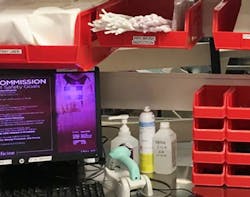Use of alcohol in the workplace … as a disinfectant
Q
I was told I could not have alcohol at my workstation. Is that true?
A
I want to expand on your question to ask it this way; “Can I use alcohol in a medical device reprocessing department?”
First and foremost, it depends on the medical devices you have in your department and what their specific instructions for use (IFU) states that you need to do to reprocess that device properly.
Let’s first start with what we know about alcohol, specifically isopropyl alcohol, which is the most common type used in a medical device reprocessing department.
Isopropyl alcohol, particularly in solutions between 60 percent and 90 percent alcohol with 10 – 40 percent purified water, is rapidly antimicrobial against bacteria, fungi, and viruses. Once alcohol concentrations drop below 50 percent, usefulness for disinfection drops sharply. Isopropyl alcohol is flammable, limiting its use as a surface disinfectant to small surface-areas and s in well-ventilated spaces only.
With prolonged and repeated use of isopropyl alcohol as a disinfectant, it can also cause discoloration, swelling, hardening, and cracking of rubber and certain plastics. Isopropyl alcohol has protein fixation properties that could lead to the retention of organisms within or on devices, such as an endoscope. Isopropyl alcohol and other disinfectants might affix biofilm to surfaces and make them difficult to remove. Therefore, it is essential to know how, where, and when to use isopropyl alcohol in any situation, if at all.
Let’s now look at what the standards state and then a few original equipment manufacturer’s (OEM) IFU of some devices to complete the picture and answer the question.
ANSI/AAMI ST79 has information concerning alcohol, which states that instruments and devices should not be treated with any additional chemical (e.g., alcohol, disinfectant wipes) unless such treatment is specifically recommended in the manufacturer’s written IFU.
It must be noted that there is disagreement when it comes to the use of alcohol and flexible endoscopes. Some OEMs IFU and certain countries still recommend its use, and others do not. In fact, the British Society of Gastroenterology states that, “Due to the fixative properties the use of alcohol to assist in drying endoscopes is no longer recommended.” Therefore, understanding the specific standards and guidelines for instrumentation is critical.
In sterile processing, we are trained to follow the manufacturers’ IFU, so that is why the answer to the question of using alcohol is, “it depends.” Ensuring a medical device is clean and functional per the OEM IFU is so crucial for your role in the facility. If not enough information is available in the IFU, then you should perform research to make a policy that is best for your facility.
Many OEMs gives specific direction in using alcohol during the inspection process. Here is how one OEM informs the technician about using alcohol in cleaning their telescope without a working channel during the inspection process.
• Then thoroughly re-rinse with demineralized water.
• Dry the outside with a lint-free disposable cloth.
• Remove any soiling of the glass surfaces or the light entry and light exit surfaces by wiping with a cotton swab soaked with 70 percent alcohol (ethanol, isopropanol) (wooden swab carrier, not metal or plastic).
A medical device reprocessing department has hundreds if not thousands of different types of medical devices in their department, so having alcohol available at the workstation is necessary. I also would like to see departments do an inventory of the devices they reprocess and see which ones require alcohol during the inspection (prep and packing) process stage and add that information to their count sheet.
When a department develops its standard operating procedures (SOP), using these questions as an example, facilities should do research and involve all parties to make a sound SOP for their department. Once that is complete, it should be communicated to all employees. This helps to ensure a uniformed understanding of why we do what we do because, in the long run, we want to do it right every time.
My last piece of advice is to make sure you perform the following steps if/when you do use alcohol on the clean side (or any place in the department). First, put the date and time on the opened bottle. Then, put your initials on it. Lastly, keep the cap secure when not in use and have it in a spot that will be hard for it to tip over. Most of all, use the alcohol correctly and only on the devices that require its use.
References:
Association for the Advancement of Medical Instrumentation; ANSI/AAMI ST79:2017; Page 40
BSG – Guidance for Decontamination of Equipment for Gastrointestinal-Endoscopy2017; Edition 3
Reprocessing of RICHARD WOLF Heat-Stable Instruments GA-J020 / en / 2014-05 V17.0 / PDI 13-6891
Instructions for Care & Cleaning of Miltex Endoscopes and Laparoscopic Surgical Hand Instruments General Reprocessing Instructions for KARL STORZ Products (USA) - PI-000035-20.1 2-03-11
Alcohol fixation of bacteria to surgical instruments increases cleaning difficulty and may contribute to sterilization inefficacy: Am J Infect Control 2017 Aug 1;45(8):e81-e86. doi: 10.1016/j.ajic.2017.04.286. Epub 2017 Jun 8
About the Author

Stephen M. Kovach
Stephen M Kovach, BS, CFER, started in the medical field in 1975 as a sterilization orderly and has worked in many positions within the Healthcare Industry. He presently is Clinical Educator Emeritus at Healthmark, A Getinge company.

